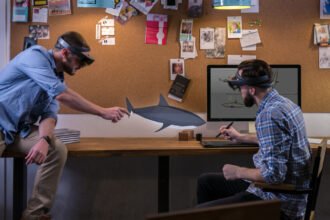 The holy grail of virtual reality, the one that’s always been out of reach until now, is presence.
The holy grail of virtual reality, the one that’s always been out of reach until now, is presence.
 The holy grail of virtual reality, the one that’s always been out of reach until now, is presence.
The holy grail of virtual reality, the one that’s always been out of reach until now, is presence.
In the VR community, “presence” is a term of art. It’s the idea that once VR reaches a certain quality level your brain is actually tricked — at the lowest, most primal level — into believing that what you see in front of you is reality. Studies show that even if you rationally believe you’re not truly standing at the edge of a steep cliff, and even if you try with all your might to jump, your legs will buckle. Your low-level lizard brain won’t let you do it.
With presence, your brain goes from feeling like you have a headset on to feeling like you’re immersed in a different world.
Computer enthusiasts and science fiction writers have dreamed about VR for decades. But earlier attempts to develop it, especially in the 1990s, were disappointing. It turns out the technology wasn’t ready yet. What’s happening now — because of Moore’s Law, and also the rapid improvement of processors, screens, and accelerometers, driven by the smartphone boom — is that VR is finally ready to go mainstream.
Once VR achieves presence, we start to believe.
We use the phrase “suspension of disbelief” about the experience of watching TV or movies. This implies that our default state watching TV and movies is disbelief. We start to believe only when we become sufficiently immersed.
With VR, the situation is reversed: we believe, by default, that what we see is real. As Chris Milk, an early VR pioneer,explains:
You read a book; your brain reads letters printed in ink on paper and transforms that into a world. You watch a movie; you’re seeing imagery inside of a rectangle while you’re sitting inside a room, and your brain translates that into a world. And you connect to this even though you know it’s not real, but because you’re in the habit of suspending disbelief.
With virtual reality, you’re essentially hacking the visual-audio system of your brain and feeding it a set of stimuli that’s close enough to the stimuli it expects that it sees it as truth. Instead of suspending your disbelief, you actually have to remind yourself not to believe.
This has implications for the kinds of software that will succeed in VR. The risk is not that it’s boring, but that it’s too intense. For example, a popular video game like Call of Duty ported to VR would be frightening and disorienting for most people.
What will likely succeed instead are relatively simple experiences. Some examples: go back in time and walk around ancient Rome; overcome your fear of heights by climbing skyscrapers; execute precision moves as you train to safely land planes; return to places you “3D photographed” on your last vacation; have a picnic on a sunny afternoon with a long-lost friend; build trust with virtual work colleagues in a way that today you can only do in person.
These experiences will be dreamt up by “experience makers” — the VR version of filmmakers. The next few decades of VR will be similar to the first few decades of film. Filmmakers had no idea what worked and what didn’t: how to write, how to shoot, how to edit, etc. After decades of experiments they established the grammar of film. We’re about to enter a similar period of exploration with VR.
There will be great games made in VR, and gaming will probably dominate the VR narrative for the next few years. But longer term, we won’t think of games as essential to the medium. The original TV shows were newscasts and game shows, but today we think of TV screens as content-agnostic input-output devices.
VR will be the ultimate input-output device. Some people call VR “the last medium” because any subsequent medium can be invented inside of VR, using software alone. Looking back, the movie and TV screens we use today will be seen as an intermediate step between the invention of electricity and the invention of VR. Kids will think it’s funny that their ancestors used to stare at glowing rectangles hoping to suspend disbelief.










